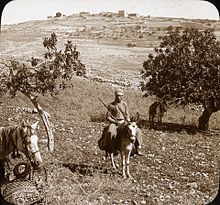Ramathaim-Zophim
רמתיים־צופים | |
 Ramah viewed from the south, image c. 1915 | |
| Alternative name | Ramah, Ramatha |
|---|---|
| Region | Southern Levant |
| Coordinates | 31°51′00″N 35°13′54″E / 31.85°N 35.231667°E |
| Type | town |
| History | |
| Cultures | Kingdom of Judah |
Ramathaim-Zophim (Hebrew: רמתיים־צופים), also called Ramah (Hebrew: רָמָה) and Ramatha in the Douay-Rheims, is a town that has been identified with the modern Nevi Shmuel neighbourhood ("the prophet Samuel"), about 4 or 5 miles north-west of Jerusalem.
The home of Elkanah, Samuel’s father (1 Samuel 1:19 ; 2:11 ), the birthplace of Samuel and the seat of his authority (1 Sam. 2:11; 7:17), the town is frequently mentioned in the history of that prophet and of David (15:34; 16:13; 19:18-23). Here Samuel died and was buried (25:1).
Benjamin of Tudela visited the site when he traveled the land in 1173, noting that the Crusaders had found the bones of Samuel in a Jewish cemetery in Ramla on the coastal plain and reburied here, overlooking the Holy City.
The traditional tomb site, which became known as Neby Samwil (“the prophet Samuel”), may have been Mizpah in Benjamin, where Samuel was appointed leader of the Israelites (1 Sam. 7:5-6).
However, if Mizpah in Benjamin was Tell en-Nasbeh on the Nablus road, Ishmael who had assassinated Gedaliah would not have fled to Ammon via Gibeon [1] which is located to the West near Neby Samwil which overlooks Jerusalem. Furthermore, Judas Machabeus, preparing for war with the Syrians, gathered his men "to Maspha, over against Jerusalem: for in Maspha was a place of prayer heretofore in Israel".[2]
Some, e.g. Petrus Comestor (ca. 1100-1179) in his Historia Scholastica, Cap. CLXXX: De sepultura Domini, have identified Ramathaim-Zophim as Arimathea of the New Testament.
References
This article needs additional citations for verification. (May 2008) |
- ^ Jeremiah Chapter 41 Verse 10-12 Mechon Mamre
- ^ I Mach., iii, 46, cited in Herbermann, Charles, ed. (1913). . Catholic Encyclopedia. New York: Robert Appleton Company.
31°51′00″N 35°13′54″E / 31.85000°N 35.23167°E

